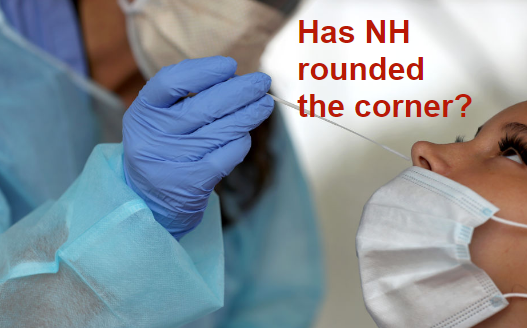
More than 84,000 people were diagnosed with COVID-19 across the United States on Friday, a new single day nationwide high, according to Reuters, and on Saturday 129 new cases were identified here in New Hampshire, but does this mean we're in for a "long, dark winter" as Democrat presidential candidate Joe Biden said at Thursday's debate, or that there may be some light at the end of the tunnel.
If you look at the data it might be the latter.
Consider this: During the recent active-case surge in the Granite State 852 cases were identified between Oct. 11 and Oct. 21, but only nine of those cases required hospitalization, DHHS spokesman Jake Leon said on Friday.
That's a hospitalization rate among those cases of 1.05 percent.
In the early days of the pandemic, when only those displaying severe symptoms were urged to get tested, the hospitalization rate was higher among cumulative cases. It didn't start to come down till testing became available and was encouraged for those with mild symptoms and later in the spring for those with no symptoms.
That's why the hospitalization rate among cumulative cases was 14 percent on April 25, hovered around 10 through the summer and then dropped to 9 percent in September and stands at 7 percent today.
So the surge in cases is largely due to testing, and the high hospitalization rate is a result of early testing that focused on testing the sick, not the healthy.
We now know that at least in the 10-day period that The Rochester Voice examined this month only a little more than 1 percent of those tested were hospitalized.
The key metric in ensuring our health care infrastructure is able to handle any COVID-19 surge is our hospitalization rate, so with only 9 current hospitalizations statewide, we're in good shape.
Now consider this. DHHS announced 120 newly identified cases on Thursday and another 129 on Friday; none were hospitalized. Further, the test positivity rate was low, at 1.3. That means the hospitalization rate is likely lower than the 1.05 percent indicated in the numbers compiled between Oct. 11-21.
Now let's crunch the testing numbers. In April we were testing about 600 a day. Compare that to Saturday when 13,155 tests were administered in the Granite State, according to covidtracking.com. That's why the positivity rate is so low: the sheer number of those tested, including many school age children and young adults wanting to play hockey.
During the May surge in COVID-19 hospitalizations we had many days when there were more than 150 newly identified cases. During that surge current hospitalizations peaked at 126 on May 14.
Now look at the current surge we are in the midst of, which shows even greater numbers of new cases than in May but a hospitalization rate some 85 percent below the spring surge.
Deaths are also way down from the May surge.
Let's remember why we did the lockdown: to get ahead of the curve and reduce the threat of overloading our health infrastructure.
That's been done, and the recent surge proves it.
Specific numbers from the state of Massachusetts (pop: 7M) for Oct. 11-Oct 21 were not available but on Friday they tested almost 100,000 individuals, identifying almost 6,500 cases with almost 5,000 current hospitalizations, half of their high of almost 11,000 on July 27.
Meanwhile, Maine (pop: 1.3M) is testing about 5,800 daily, with 42 new cases on Friday and eight current hospitalizations statewide.
Vermont (pop: 624,000) saw a little over 1,700 tests on Friday, with 24 newly identified cases and four current hospitalizations.













